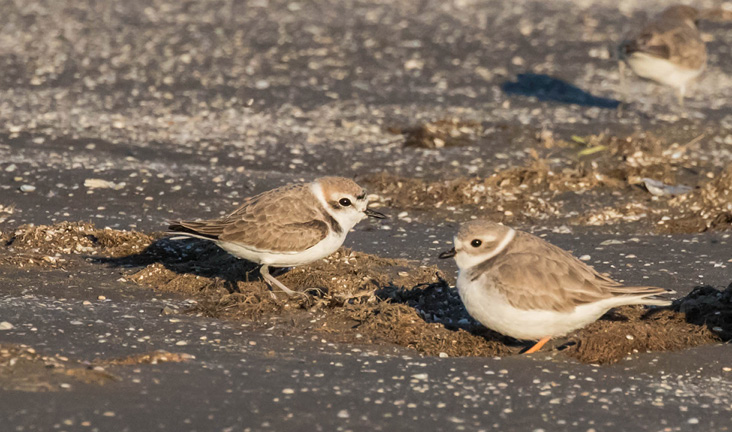Wayne R. Petersen

DAVID LARSON
As a confidence builder in the wake of the last issue's overly abstruse mystery bird, this issue offers readers a peace offering—a straightforward field identification problem. It should be obvious that in this issue we're looking at shorebirds, not some ambiguous species where even the family identity is in question.
When thinking about shorebird identification, a convenient way to begin is to place an unknown species into its correct family. Although it's true that there are a number of shorebird families, it is also true that the majority of Massachusetts shorebirds belong to either the family Charadriidae (plovers) or Scolopacidae (sandpipers and their allies). Distinguishing between members of these two groups is actually quite simple. Plovers have short, straight, blunt-tipped bills, stubby necks, abrupt foreheads, often angular-looking heads, plump bellies, and fairly large eyes. Sandpipers, on the other hand, have relatively longer, slimmer bills that can be either straight, upturned, or downturned; slim necks, rounded heads, generally slim bodies, and smaller eyes. Plovers also forage more deliberately than sandpipers (more like American Robins), and they generally have a more erect posture than most sandpipers. With these features in mind, it should be apparent that the mystery birds are plovers.
Plovers exhibit three primary ventral patterns: those with black underparts (e.g., Black-bellied Plover in breeding plumage), those with whitish, unbanded underparts (e.g., Black-bellied Plover in nonbreeding or juvenal plumage), and those with prominent dark neck collars which may be either partial or complete. A close examination of the plovers in the photograph (especially in the color version on the website) shows that both individuals have partial collars at the sides of their neck and upper breast. In Massachusetts only two regularly-occurring plover species share these features, Semipalmated Plover and Piping Plover. Additionally, the dorsal coloration on Semipalmated Plovers is dark brown (the color of wet sand), while Piping Plovers are much paler above (the color of dry sand). So far everything is pointing to Piping Plover as the identity of the mystery birds—but wait! Better take more than a glance at these two plovers!
A close look shows that the plover on the left has a thinner, more pointed bill than the one on the right, it possesses a distinct black bar on its forehead, and its legs are gray. The right-hand plover has a stubbier, more blunt-tipped bill, no distinct black bar on its forehead, and its legs are bright orange. So what we have here are two look-alike plover species, a rare Snowy Plover (Charadrius nivosus) on the left, and a Piping Plover (Charadrius melodus) in non breeding plumage on the right.
The Snowy Plover is a rare vagrant in Massachusetts with only a single record for the state, while the Piping Plover is a federally threatened species in Massachusetts with only a coastal breeding population of approximately 650 pairs in the state. Piping Plovers typically arrive in Massachusetts in mid-March, and most have departed by mid-September.
David Larson photographed this interesting combination of plovers in southwestern coastal Louisiana in November 2017.
Wayne Petersen